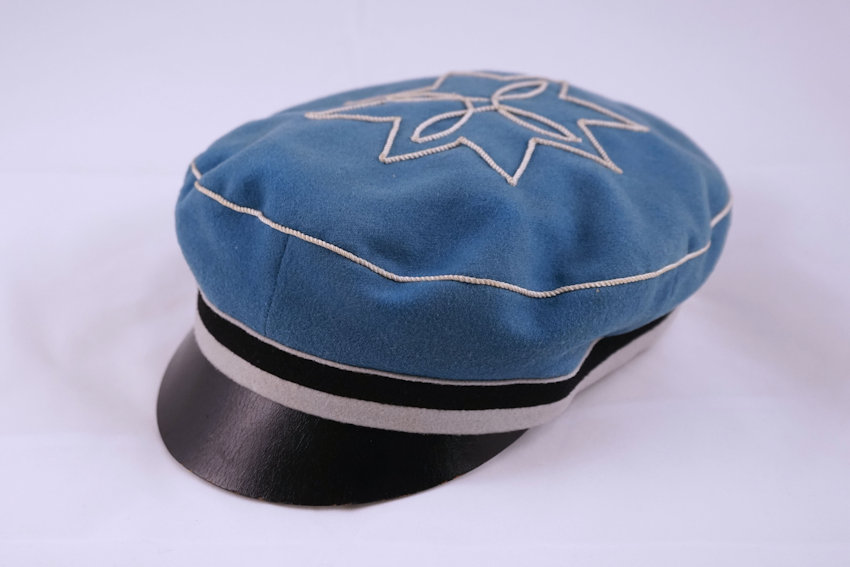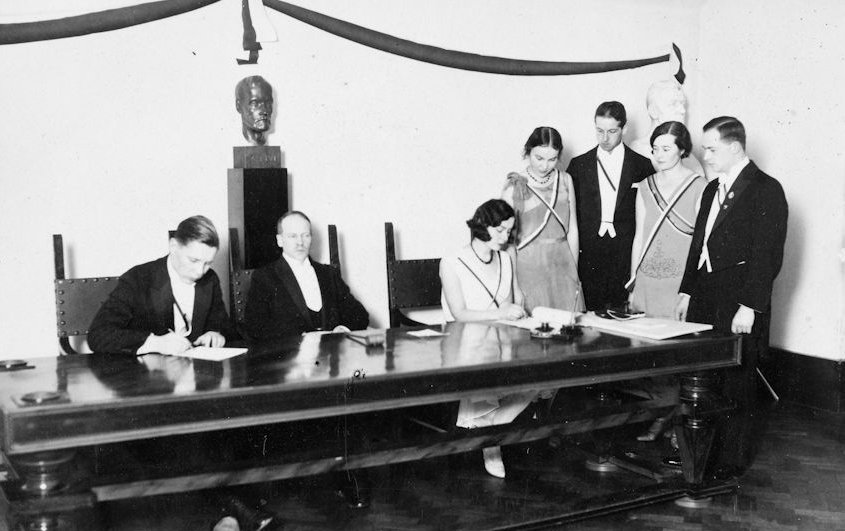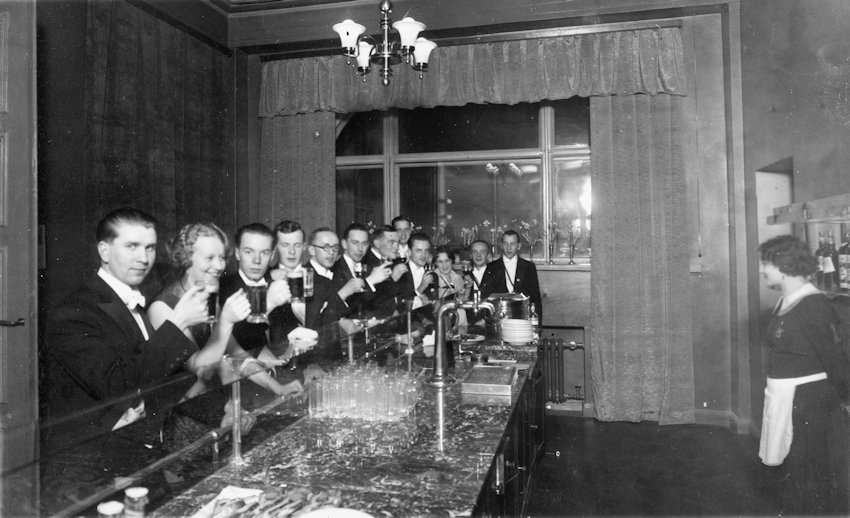This time, the Object of the Month is an interesting recent donation to the Helsinki University Museum that consists of photos mainly illustrating the activities of the Hämäläis-Osakunta student nation (a student association originally affiliated with the Häme region of Finland) in 1929 and 1930. What makes this donation particularly valuable is that the original owner of the photos, Moira Lindfors (née Tuomikoski, formely Hormi, 1908–1979) has written on their back when and where they were taken, often also noting the names of the people in them.
The grandmother of the Berlin-based donor was Irja Tuomikoski, known as Moira, who completed her matriculation examination in Hämeenlinna and began to study law at the University of Helsinki in autumn 1928. She joined the Hämäläis-Osakunta student nation, a community of close to 1,000 students in the late 1920s. In 1930 the members of Hämäläis-Osakunta comprised up to one-quarter of all members of the Student Union.
The donated photos were discovered when I went to view a large set of photos sent to the Vantaa City Museum. My aim was to identify people in the photos who were associated with Katrineberg Manor in Vantaa, which I was investigating. Browsing the photos, I realised that they included rare depictions of student life.
I found a total of 31 photos which the owner eventually donated to the Helsinki University Museum at my request. Many of the photos were from 1929 and showed, for example, a procession celebrating the birthday of J. V. Snellman, a Finnish baseball tournament between student nations, excursions by Hämäläis-Osakunta, Flora Day celebrations and individual members of the student nation. I became particularly interested in a photo showing male students in dark caps and two female students in white caps, standing in front of a ship. I recognised the darker caps as those worn by Estonian students because I had previously visited the University of Tartu Museum in Estonia.

Hämäläis-Osakunta’s Estonian friendship treaties
The Fennoman movement was a strong force in various Finnish student nations in the 1920s and 1930s, and many student nation members belonged to the Academia Karelia Society, a nationalist and Finno-Ugric activist organisation. An Estonian proposal in the 1920s for the establishment of a kindred peoples’ club led to the organisation of an annual Finnish-Estonian student get-together. The first event took place in Helsinki in 1925, where the participants had the idea of concluding friendship treaties between student organisations. The idea took off and numerous treaties were subsequently concluded.
At the time, there were a total of 13 Estonian student organisations, known as korporatsiooni (‘fraternity’) and seltsi (‘society’) and intended for either men or women. The former organisations were often referred to with the abbreviation Korp! (Estonians often use an exclamation mark in academic abbreviations). Various student nations concluded friendship treaties at a rapid pace particularly in 1930 when 10 Finnish student nations entered into a friendship treaty with an organisation from the University of Tartu. The first student nation to sign a friendship treaty with the Tartu-based Eesti Üliöpilaste Seltsi was Pohjois-Pohjalainen osakunta in 1928.
In autumn 1929, curator Gunnar Suolahti of Hämäläis-Osakunta brought back a message from a kindred peoples’ celebration held in Tartu. Apparently, Korp! Sakala, a local student organisation, was keen to establish a friendly relationship with Hämäläis-Osakunta. This may have been due to the fact that Oskar Rütli, a founding member of Korp! Sakala and an influential local alumnus, was married to Mimmi Auer, who hailed from the Häme region and many of whose relatives had been members of Hämäläis-Osakunta. In addition, some pointed to similarities between the Viljandi (known as Sakala in ancient history) and Häme regions. Hämäläis-Osakunta decided to send three members, Aatos Tavaila, Katri Halme and Lauri Puntila, to Tartu for the 20th annual celebration of Korp! Sakala from 15 to 17 November 1929 to sign a friendship treaty between the organisations. The student nation’s own 60th anniversary would have taken place on the same weekend, but it had been postponed at a previous meeting until January of the following year.

Although not mentioned separately in the treaties, the most important form of cooperation was the exchange of scholarship recipients. Oskar Rütli donated 4,000 Finnish markka of his own funds as a ‘kindred people’s scholarship’ to the University of Tartu, and Hämäläis-Osakunta established a similar scholarship. A total of 13 members of Hämäläis-Osakunta studied in Tartu, while 11 Sakala members studied in Helsinki. The scholarship recipients were also invited as members of the host organisation: all 11 Sakala members joined Hämäläis-Osakunta and the 13 Hämäläis-Osakunta members joined Sakala. The Finnish scholarship recipients made happy memories during their studies in Tartu and membership in Sakala. Most Finns stayed in Tartu, the ‘Heidelberg of the North’, for a few months, and the scholarship funds were sufficient to cover fairly lavish student activities.
The Korp! Sakala building was designed by the Finnish architects Armas Lindgren and Wivi Lönn, who were also responsible for the New Student House in Helsinki. The Sakala building was completed on Veski street in Tartu in autumn 1911, a year after the completion of the New Student House. The solemn inauguration ceremony took place on 29 and 30 October 1911. Oskar Rütli played an active role in the acquisition of the plot and wrote to architect Lindgren, asking him to design the building.
Hämäläis-Osakunta’s 60th annual celebration
The student nation’s 60th annual celebration was preceded by an evening get-together at the New Student House on 25 January 1930 as well as a festive meeting, a gala dinner and a ball in the Banquet Hall of the Old Student House the following night. During the festivities, the establishment of a student nation for the Suur-Häme region was discussed, as was the consolidation of Hämäläis-Osakunta’s alumni relations, for example, through an alumni association. No such association existed in Finland at the time, but Estonian student organisations had established alumni associations, and Finns were keen to follow their example.
Some 500 people attended the dinner, including the Estonian ambassador to Helsinki, Rector Antti Tulenheimo and Chancellor Hugo Suolahti of the University of Helsinki as well as professors, alumni and members of other student nations and friendship associations. Several speeches were given. Most notably, an address to the University on the hot topic of the day, the ‘finnicisation’ of the University. The Estonian guests had also been taken into consideration by decorating the student nation’s facilities in the colours of Sakala and Filiae Patriae. The speech by Jaak Roosson, chair of Korp! Sakala, was received with a round of applause. The flags of the Estonian organisations were placed on the dinner table side by side with the red-and-white flags of Hämäläis-Osakunta. The next day, the visitors met with the rector and the chancellor, conversing in a mixture of Estonian and Finnish.

Later friendship treaties
Thanks to the treaties, the Hämäläis-Osakunta members and the Tartu students continued to interact until 1939, exchanging books, attending each other’s parties and receiving scholarships to study at the partner university. Tensions emerged in the mid-1930s as a result of the authoritarian activities of leading Estonian politician Konstantin Päts. The conservative and right-wing ideas espoused by Estonian student organisations also led to criticism among student nation members. However, Uuno Peltoniemi, a Finnish representative in the kindred people’s club, noted that Finns should also learn lessons from their Estonian counterparts in terms of community spirit, activities for first-year students, and alumni relations. Accordingly, in the 1930s Peltoniemi and curator Puntila developed a system of orientation for first-year students in Hämäläis-Osakunta, with the aim of distributing information and increasing commitment. The system was soon adopted by all Finnish student nations.
In 1940 student organisations were banned in Estonia, but they continued their activities in exile in countries such as Sweden, the United States and Canada. The friendship treaty with Hämäläis-Osakunta was terminated as a result of political pressure in the 1970s, but once Korp! Sakala recommenced its activities in Tartu in 1989, it concluded a new friendship treaty with Hämäläis-Osakunta.
Pia Vuorikoski
Head of exhibitions
References to Estonian-language sources: Merike Holmberg, LicPhil
Translation: University of Helsinki Language Services
Sources:
Ville Eerola: Helsingin yliopiston osakuntien ystävyyssopimukset Viroon itsenäisen Suomen aikana. Lyyra 2016.
https://www.sakala.ee/korp-sakala-ja-h%C3%A4me-osakonna-suhted (“Korp! Sakala ja Häme Osakonna suhted”)
https://estofilia.finland.ee/2018/01/mimmi-rutli.html (Estofilia 100)
Seppo Kuusisto: Kansallishenkeen uskoen. Hämäläis-Osakunnan historia 2. 1918–1970. Vaasa 1978.
Newspapers:
Aamulehti, 14 November 1929
Päevaleht, 5 February 1930, issue 35
Ylioppilaslehti, 16 November 1929
